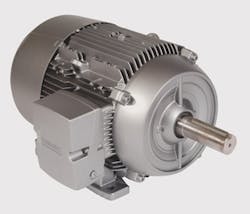16. In the process, the company also hopes to snatch market share from industry leaders in the North American market for low voltage AC motors—a list that includes companies such as Baldor Electric, Regal-Beloit and Rockwell Reliance Electric.
“A motor is a motor is a motor. But we think we’ve done some things here that are going to bring us from the lower portion of the pack to the top,” declares John Caroff, Norwood, Ohio-based marketing manager, low voltage motors, for Siemens Energy & Automation Inc. (www.sea.siemens.com)
Siemens’ three new lines of one- to 20-horsepower AC motors include what the company says is the most energy-efficient design on the market. By offering new AC industrial motors with ratings up to 10 percent higher than NEMA Premium—a motor efficiency specification set out by the National Electrical Manufacturers Association—Siemens now lays claim to the title of “motor efficiency leader,” Caroff asserts.
Technology too
Further, the new Siemens motor designs include “breakthrough technology” in the form of die cast copper rotors, Caroff adds. Though copper rotors have traditionally proven difficult and costly to cast, the material delivers superior efficiency compared to traditional die cast aluminum rotors. And Siemens hopes to capture some additional cachet by being first to market with the technology, Caroff says. There may be some fractional motors on the market that use die cast copper rotors, he allows. “But I don’t know of anybody else globally that is manufacturing this size products (one- to 20-horsepower) with die cast copper rotors.”
Confirming that claim is Muhammad Mubeen, a Radford, Va.-based senior research associate for Motion Tech Trends, an Inglewood, Calif., market research firm that specializes in electric motors, drives and motion control. “Maybe there are some exceptions that I don’t know about, but everybody today uses cast aluminum rotors,” says Mubeen.
Given that the resistivity of copper is about 50 percent less than that of aluminum, it is easy to understand why motors using die cast copper rotors would be more efficient, Mubeen says. But copper, which has a much higher melting point than aluminum, is much more difficult to cast, Mubeen says. He calls the Siemens advance “a big deal relative to motor manufacturing.”
Three lines
Siemens’ three new motor product lines include general purpose cast iron and severe duty cast iron frame motors, as well as a line built with die cast aluminum frames aimed at the low-cost original equipment manufacturer (OEM) market. The latter line features a bolt-on foot design for mounting flexibility, and offers better rigidity than traditional low-cost rolled-steel frame motors, Caroff says. All three new lines are offered in what Siemens calls “high efficiency,” using traditional die cast aluminum rotors, and in an “ultra” NEMA Premium line that features the die cast copper rotors. Other motor advances include special stator designs, as well as cooling, insulation and rotating assembly design innovations.
The new one- to 20-horsepower products introductions are the first phase of what Caroff says amounts to “a full redesign of our complete product line.” Future Siemens plans call for the die cast aluminum frame line to be expanded to 30 horsepower, while the cast iron motor line will be increased to 400 horsepower.
Caroff sees the new lines providing a boost to Siemens’ North American industrial motor business over the next several years. Siemens is already the world’s largest motor manufacturer, he says, and is number one in the large-voltage motor business. But in the low-voltage motor market—which Caroff defines as 600 volts or less—the company’s North American market share has been “less than stellar,” he concedes, amounting to “low double digits” for low-voltage motors in the one- to 400-horsepower range. That market today totals about $1.6 billion annually, he says.
Despite the apparent energy savings advantages of Siemens’ new NEMA Premium line, that won’t lead automatically to more motor sales, some point out. “It’s terribly difficult to sell motors based on efficiency,” Mubeen observes, “because people just look at the first cost. They don’t look at the overall lifetime costs. They should, but they don’t, and that’s just the reality.”
Caroff says Siemens is aware of that reality. But he notes that NEMA Premium motors are “the fastest-growing segment we have right now.” He adds that the company has noticed a growing interest in energy efficiency lately by more manufacturers.
Pricing on the new die cast copper rotor-based NEMA Premium motors will be just 5 percent higher than Siemens’ existing NEMA Premium line, according to Caroff. At those price points, the motors can typically pay for themselves within four to 12 months, he says, depending on factors including local energy costs and the number of factory work shifts.
Beyond that, the rest of the savings is gravy. Just a 5 percent efficiency gain over a 20 horsepower motor’s typical 20-year life can yield $12,500 in energy savings, according to one Siemens example. With tens to hundreds of motors in a single plant, Siemens says the savings realized through added motor efficiency could have a significant positive impact on a manufacturer’s profitability.
To help users calculate motor energy efficiency savings, Siemens will be offering a tool called SinaSave. The tool provides time-to-payback comparisons for different motors, including those of Siemens competitors entered by users. The SinaSave tool is expected to be available soon on the Siemens Energy & Automation Web site, at www.sea.siemens.com.

